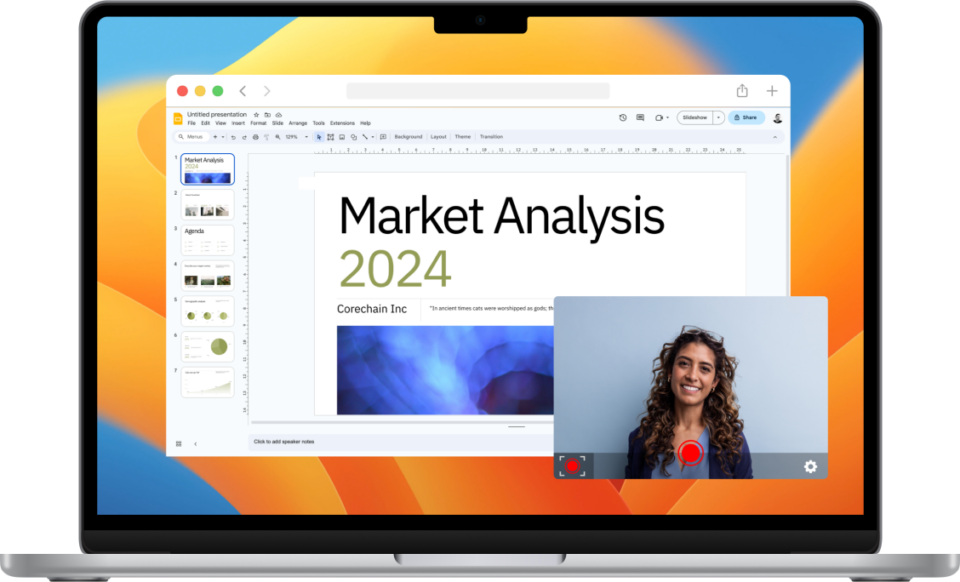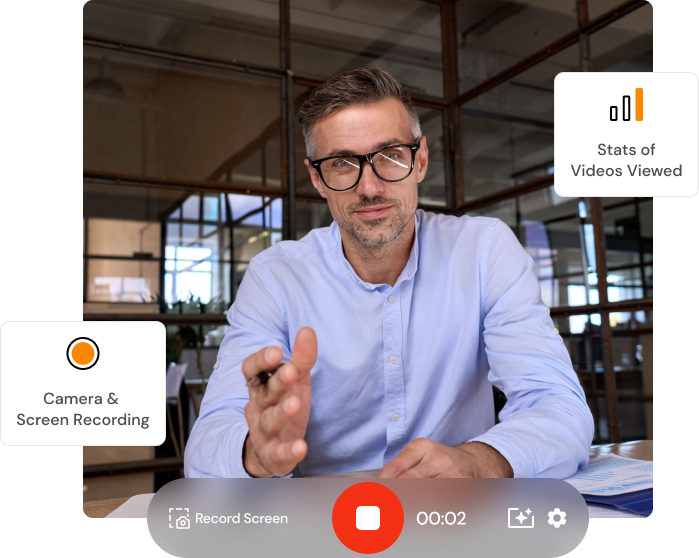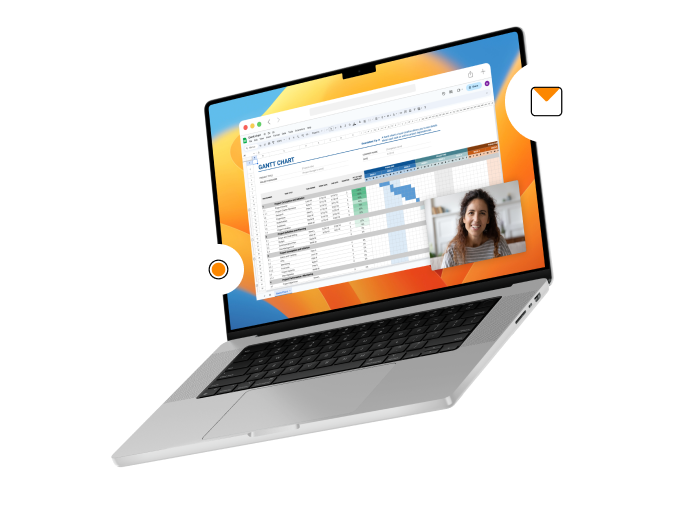The goal of sales reps like you isn’t just to win — it’s to help. But you can’t help someone if you don’t know anything about them. Your prospects are more than just a number or a target. They have emotions, stories, struggles, and triumphs — just like you. If you want them to trust you enough to buy from you, you have to show them that you understand and care about those parts of them, too. You have to connect with them in a meaningful way. And that’s where open-ended questions for sales can help.
Asking your prospects questions that prompt more than a “yes” or a “no” reply will help guide you as you uncover who they are. You see, if you do all of the talking, what exactly do you learn about them? Not much. How do you know if a partnership will work for everyone involved? You don’t. Above all, people want to buy from someone they know, like, and trust. Asking thoughtful and relevant sales qualifying questions will foster meaningful, relationship-building conversations. They demonstrate that you care, you’re trustworthy, and that you’re there to help.

25 Must-Ask Open-Ended Questions for Sales
The BombBomb Sales Team knows that you have to uncover more about your prospects than what’s in your customer relationship management tool (CRM).
Below, you’ll find a list of 25 of our team’s favorite questions that focus on human-centered selling. Human-centered selling is anchored in your prospect’s humanity. Above all, it prioritizes them over your product. And it helps separate you from digital pollution like spam, bots, and other unwanted digital distractions. Human-centered selling frames the questions you’re asking around your prospect’s emotions, rationalizations, the pain points they experience each day, and the impact of removing that pain.
We know combing through a long list of open-ended questions might seem overwhelming. So if you don’t want to dig through the entire post, we’ve broken it down into categories to make finding the sales questions you need at every stage in your sequence as easy as possible.
Questions to Uncover Your Prospect’s Situation and Background
Questions to Determine Your Prospect’s Pain Points
Questions to Discover the Impact of Removing Your Prospect’s Pain Points
Questions to Clarify Your Prospect’s Answers
Questions to Uncover Your Prospect’s Situation and Background
Before you start asking your prospects in-depth open-ended questions for sales, you have to leverage situational and background questions to uncover who they are and how their organization works. Sales qualifying questions like the ones below are the cornerstone of the sales process. They provide the framework for meaningful conversations that establish the trust you need to build relationships with your prospects.
1. How many people are on your team?
Your CRM can provide basic information about your prospect’s role in their company. But when it comes to the internal structure of their team, you’re going to have to ask more questions.
Use situational questions like the one above to begin uncovering more details about your prospect and their team. In addition, they also provide a space for you to follow up with more in-depth, structure-focused questions. For instance, after your prospect responds, you can follow up with something like, “So where does your team of [NUMBER OF PEOPLE] fit into the sales organization of your business?” Focusing on their team and their company structure demonstrates that you prioritize how their company functions rather than what you want to sell them.
2. Would an increase in revenue help your business? [IMMEDIATE FOLLOW-UP QUESTION]
Revenue will always be part of an organization’s bottom line. So chances are, the answer to this question will be a resounding “yes.” The word “yes” evokes positive emotions. Encouraging your prospect to say it early on sets the tone for the rest of the conversation. And after you ask about revenue, it’s important to keep the conversation moving in that same positive direction. Parlay your prospect’s simple answer with something like, “So where are you pacing towards your revenue goals this quarter?”
3. How did you hear about us?
This question might seem rather basic, but it can yield some pretty impressive results.
BombBomb Account Executive Justin Doornbos says that “Asking this question guides your prospect down the path of their story. It prompts them to consider what sparked in their mind that got them to this point.”
In addition, this is also essential information for your marketing team. These details help them continue to refine and implement lead generation tactics that support you and get you in front of the best, most qualified prospects.
4. I see you’re using [A SPECIFIC TOOL], is that right? [IMMEDIATE FOLLOW-UP QUESTION]
Knowing the tools your prospects have in their tech stack is one of the keys to identifying their primary professional objectives.
For example, if you know your prospect is using Salesforce, try something like, “I see you’re using Salesforce right now, is that right?” After they reply “Yes,” follow-up immediately by asking, “Which key performance indicators (KPIs) are you tracking the most?” Or, if you’re looking for even more specific details, try something like, “Are you tracking your engagement? What are your current email open rates?”
5. What quotas or targets [DO YOU] or [DOES YOUR TEAM] have to hit?
Your prospect’s targets and quotas will impact how they envision integrating your product into their workflow. Understanding their specific goals can help you leverage that information. And it will put you in a better position to help them succeed.
6. Who is in charge of identifying/owning expansion opportunities?
You won’t get very far in the sales process without knowing who has the final say. And while many questions can help you uncover key decision-maker details, sometimes it’s best to be direct. For an alternative to this question, try asking something like, “Who else should we involve in this conversation?”
7. When implementing a new tool, what does that process look like?
Much like understanding who the key decision-makers in an organization are, you need insight into internal company processes. Having an idea of how an organization implements new technology can help both you (and your prospect) create and meet reasonable expectations over the course of their buying journey.
Questions to Determine Your Prospect’s Pain Points

After you’ve done some uncovering of your prospect’s background, the next questions you ask should help determine their pain points. It’s these open-ended questions for sales lead qualification that’ll ultimately help you discover their very specific needs.
BombBomb Director of Sales Dan Hawkins says that “All of the questions you ask your prospects should help you uncover the core problem they’re experiencing. You’re in this position to help them. And you’re not just trying to solve symptoms of a problem; you’re trying to discover the underlying condition that leads to those symptoms.”
In other words, the more understanding you have of your prospect’s core problem, the better you’ll be able to help provide them with something of value.
8. What’s the most important thing that you want to get out of this meeting?
BombBomb Account Executive Glenn Bush asks this question early on in the conversation once he’s gone through the ACE acronym — appreciate (I appreciate your time), check (check the end time), and end goal (confirm the end goal) — and the agenda.
Recent sales research by Hubspot highlights that for 69% of prospects, the number one way to create a positive sales experience is for reps to listen to their needs.
Glenn says, “I use this question to ensure there isn’t anything I’m missing. Above all, by asking your prospects what they want to get out of the meeting, you’re allowing them to express their goals. As a result, it humanizes them by putting the focus on their needs. This question also provides a space for anything additional they may want to tell you.” Glenn adds, “Your prospect’s answer then gives you something to reference at the end of the call. For example, try something like, ‘You said you wanted to cover _______. Did I get that right?’”
9. How are you using [YOUR TYPE OF PRODUCT] in your process or workflow?
An excellent way to encourage your prospect to think about what they may be missing from their workflow is to ask them how they’re using the type of product you’re selling. This open-ended question for sales is also one of the best cold call opening lines that won’t piss off your prospects. (You can read more about that here.)
10. What metrics do you need to see [YOUR PRODUCT] make the most impact on to determine success?
If you’re looking for direct insight into the symptoms of your prospect’s pain to get to the core of the problem, this is a great place to start. Your prospect’s answer can help uncover some of the deeper obstacles they’re experiencing. For instance, it may help them identify the areas where they may be underperforming.
11. Can you tell me about who [YOU, YOUR SALES REPS, TEAM, ETC.] are/is reaching out to?
Open-ended questions for sales tend to begin with “how, what, or why.” But that doesn’t always have to be the case.
Consider starting open-ended questions with specific words or phrases that center around your prospect’s humanity. For example, incorporating the term “you” helps put the focus directly on your prospect. Questions that start with phrases like, “Can you tell me about…” or “Where would you…” center the conversation about your prospective customer.
To learn more about power words like you that can help with sales success, check out this post.
12. What are you doing currently to solve this problem?
Chances are, if your prospects express a pain point, they either don’t have a solution for their problem, or the one they have in place isn’t effective. Therefore, it’s crucial to figure out what solutions they’ve already tried to implement. (This can also help you avoid suggesting something they’ve already tried.)
13. Why are we looking at this now?
Instead of asking your prospect, “Is this a priority?” Consider rephrasing the question to, “Why is this a priority now?” Making it an open-ended question helps create an ongoing discussion. One that centers around your prospect’s current goals and pain points. In addition, the word “now” adds a greater sense of urgency to your conversation. How can you help them now?
14. How do you lose deals to competitors?
Asking about your prospect’s competitors and their lost opportunities allows you to assess where they may be falling short. Is their competition leveraging something that they aren’t? It also helps open the door for more in-depth dialogue about how your solution can help them fill in that gap.
15. How do I help support your next steps now?
BombBomb Account Executive Danny Doerksen knows that this question can provide a lot of insight into your prospect’s internal decision-making processes. In his experience, the answers tend to uncover key details like who else needs to be involved and the timeline of their decision-making process.
Danny also says, “This question emphasizes how you can help your prospect by acting as a resource. It’s about providing value and supporting them in their next steps toward bringing your product to market within their organization.” He continues, “Sure, I could ask, ‘What needs to happen next to get you to buy?’ but I’d rather position this question in a more human-centered way that shows them I’m here to help — not simply to sell them something.”
Questions to Discover the Impact of Removing Your Prospect’s Pain Points

Guiding your prospect through the buying journey means helping them to see for themselves what you already know: Your product will alleviate their pain. But this isn’t something you can say and just expect that they’ll buy-in.
That’s where open-ended impact questions come into play. Impact questions like the ones below focus on your prospect’s emotional decision-making (so, how your solution impacts them) and their rational decision-making (how your solution impacts their company).
16. What would happen if you didn’t choose our solution to solve this problem?
Emotional decision-making is based on your prospect’s feelings and expectations. And according to a report by The Advertising Research Foundation, your prospect’s emotions have a strong influence over the decisions they make.
Provoking an emotional response with open-ended questions like the one above will help guide the rational decision-making process in your favor. This is because your prospect understands how they would benefit directly from your solution before focusing on more rational and measurable concerns (such as budget limitations).
17. What was the last tool you implemented successfully, and what could you contribute to that?
Typically, it’s best to ask your prospect one question at a time. But there may be times when asking two-part questions will benefit both of you.
In this case, if you were to ask exclusively about the last tool your prospect implemented, the answer would likely be one or two words. But asking the additional question of why they successfully implemented that tool emphasizes (and reminds them) that integrating new tools can be an effective process that benefits them in the long run.
18. What got you excited about [YOUR COMPANY] or [YOUR PRODUCT]?
Excitement is positive; it’s contagious — use it to your advantage! BombBomb Account Executive Clarissa Gidcumb says, “This question tends to give me a lot of the ammo that I need to move the call in a positive direction.” She explains, “My prospect usually starts sharing the vision of what they like about our product and how their team might use it.”
19. How do you see your [TEAM] or [ORGANIZATION] using [YOUR TYPE OF PRODUCT]?
Asking your prospect to look at your solution through a broad lens beyond themselves prompts them to reflect on how they can implement it in their organization. It also encourages them to look beyond their emotional considerations and analyze how your product can help alleviate some of their organization’s pain points.
20. Tell me what things would be different if you could [CONVERT LEADS HIGHER, GET BETTER SHOW RATES, ETC.]
There is no better way to get your prospects to understand the impact of removing their pain points than to ask them directly.
“The objective of this sales question is to provoke a visualization of how your prospect’s business could improve and be affected when they’re able to achieve better results.” Says BombBomb Account Executive Leo Rodriguez. He continues, “And not only does it help them visualize the results they want and make them tangible, but it also reveals what obstacles may be hindering them.”
21. How will being able to [PRIMARY BENEFIT OF YOUR PRODUCT] help you in your business?
While human-centered selling focuses on your prospect, you also need to demonstrate that you’re able to provide them with something of value.
Your prospect may know very little about your product. Highlighting the primary benefits and asking your prospect how it will help them indicates you have the solution for a problem they’re facing.
Your prospects always need to know what’s in it for them. Some other ways you can provide value are…
• Send a personal video message and invite them to join a webinar that provides valuable information (while also showcasing your product).
• Send information or ideas that help them solve a problem they’re experiencing (this doesn’t have to focus on your product).
• Share free resources with them that cover a topic they might be interested in.
Questions to Clarify Your Prospect’s Answers

Asking open-ended questions for sales may not always yield the results you need. And that’s where clarifying questions can help your prospects elaborate on their answers. As a result, this gives you more insight into their backgrounds, pain points, and processes.
22. When you said ______, can you tell me more about that?
Asking your prospects to tell you more about something demonstrates that you’re listening to what they have to say. And active listening conveys empathy, which fosters the trust necessary to build relationships. (Check out some of the other ways you can show empathy in sales here.)
23. What else would you _______?
Instead of asking, “Is there anything else?” try asking, “What else would you _______? This modification provides the opportunity for your prospect to talk about what they want to learn. And not only is it one of the best ways to keep your prospect talking, but it also keeps the focus of your conversation on your prospect’s needs.
BombBomb Business Development Manager Devon Bridges says, “Anytime BombBomb reps go over an agenda or a list of important points, they ask their prospects ‘what else’ questions. Questions like: ‘What else do you need to know?’ ‘What else would be helpful?’ ‘What else would you like to learn?’ Asking your prospects ‘what else?’ is an essential part of human-centered selling because it ensures they’re getting everything they need out of the conversation.”
24. What I heard you say is ______. Can you be more specific?
There are going to be times you need more information to continue a conversation with your prospects. Asking for more specific details, especially when uncovering specific pain points, is vital to having a complete understanding of your prospect’s story.
25. What did you mean when you said ______?
Honesty is vital to every relationship. And it’s especially important in business partnerships. In fact, according to recent research by Edelman, “trust is the new brand equity.” And brand trust doesn’t just begin or end with your product. Trust is earned (and kept) through honesty, integrity, human-centered communication, and at every touchpoint throughout every part of the customer experience.
It might seem insignificant, but letting your prospects know you don’t understand something they tell you conveys the honesty that helps build trust. And not only does asking for clarification help you genuinely understand what they’re saying, but it also shows your prospect that you don’t have all of the answers. It reminds them that you’re a human being, too.
Start Using These Open-Ended Questions for Sales Today
Now that you have some of the best human-centered open-ended questions for sales that’ll help you foster relationships with your prospects — put them to the test!
And after your prospects start to open up to you, follow up with a personal video. Personal video can help them feel connected to you on an even deeper human level because you’re face to face.
Ready to create video messages? Check out the BombBomb Use Case Library! Use the featured videos as a guide for making the most of the questions (and answers!) that ultimately drive your conversations towards more trust and better relationships with your prospects. And if you’re not sure where to begin your career in sales — no problem. Check out Aspireship’s SaaS Sales Foundations course to help get you on the right track towards sales success today.





